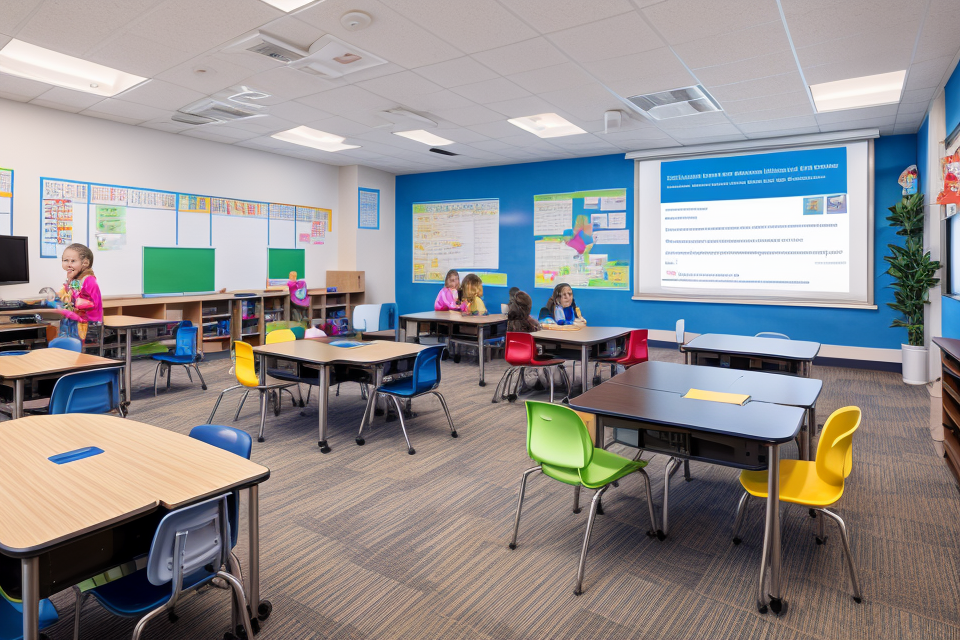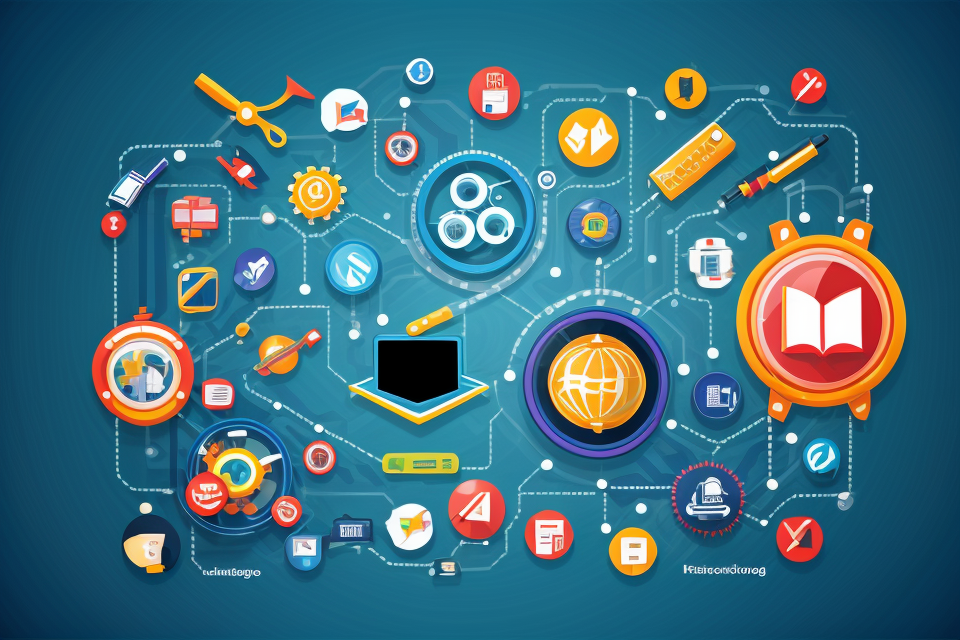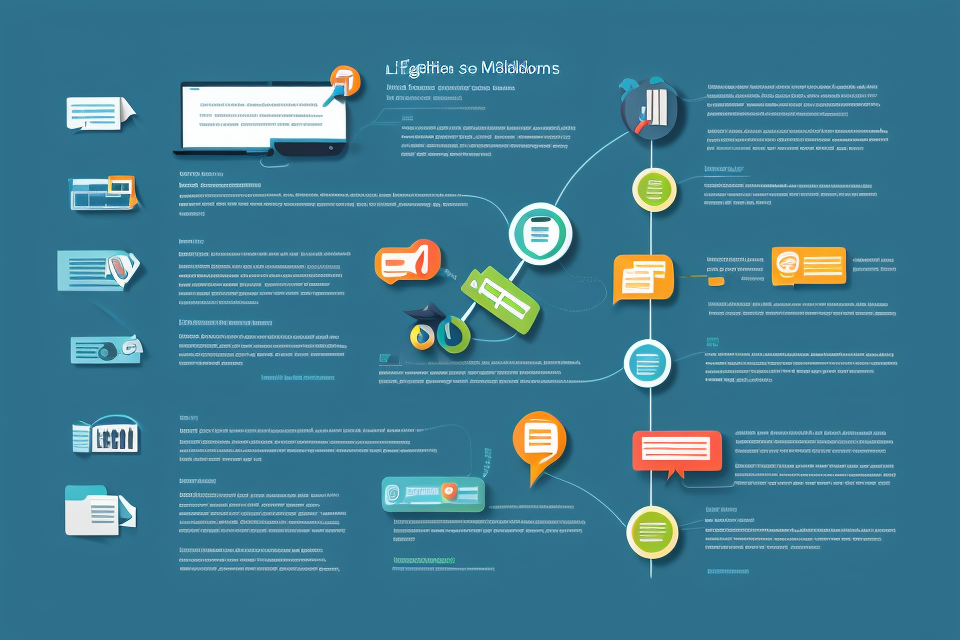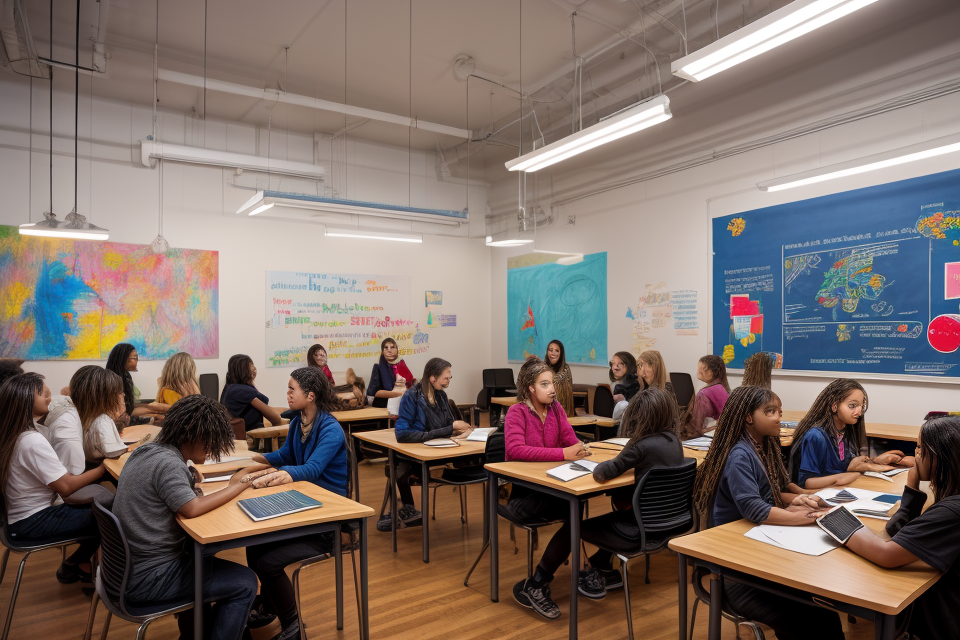
Innovation in learning refers to the use of new and creative approaches to enhance the learning experience and achieve better outcomes. This can include incorporating technology, project-based learning, personalized learning, and other strategies that challenge traditional methods of teaching and learning. The goal of innovation in education is to create a more engaging, effective, and relevant learning environment that prepares students for success in the 21st century.
The Shift from Traditional to Innovative Learning
The Evolution of Education
From Lecture-Based Teaching to Personalized Learning
The evolution of education has seen a shift from traditional lecture-based teaching methods to more personalized and student-centered approaches. This shift has been driven by the recognition that one-size-fits-all teaching methods do not meet the diverse needs of all learners.
The Importance of Individualized Learning
Individualized learning, also known as differentiation, is a teaching approach that tailors instruction to meet the unique needs, interests, and abilities of each student. This approach recognizes that students have different learning styles, strengths, and weaknesses, and seeks to provide customized support to help them achieve their full potential.
Technological Advancements and Personalized Learning
Technological advancements have played a significant role in enabling personalized learning. With the widespread availability of digital tools and resources, educators can now create customized learning experiences for their students that are more engaging, interactive, and responsive to their individual needs. For example, adaptive learning systems use data analytics and machine learning algorithms to adjust the pace and content of instruction to meet the unique needs of each student.
From Traditional to Blended Learning
Another significant trend in the evolution of education is the shift from traditional classroom-based instruction to blended learning models that combine face-to-face and online learning experiences.
The Benefits of Blended Learning
Blended learning offers several benefits for both students and educators. It provides greater flexibility and personalization in the learning experience, allowing students to work at their own pace and receive customized support. It also enables educators to use technology to enhance and supplement traditional classroom instruction, providing more engaging and interactive learning experiences.
Challenges and Considerations for Implementing Blended Learning
While blended learning offers many benefits, it also presents several challenges and considerations for educators. These include issues related to access to technology and digital resources, concerns about equity and inclusion, and the need for ongoing professional development to effectively integrate technology into the classroom.
Overall, the evolution of education is characterized by a shift towards more personalized and innovative approaches that leverage technology to enhance and supplement traditional classroom instruction.
Innovative Teaching Methods
Project-Based Learning
Project-based learning (PBL) is an innovative teaching method that focuses on engaging students in active, problem-based learning experiences. PBL has gained popularity in recent years due to its ability to foster critical thinking, collaboration, and creativity among students.
The Benefits of Project-Based Learning
The benefits of PBL are numerous. Firstly, it provides students with authentic, real-world learning experiences that are relevant to their lives. Secondly, it encourages students to take ownership of their learning and develop a deep understanding of the subject matter. PBL also promotes collaboration and communication skills, as students work together to solve problems and complete projects.
Implementing Project-Based Learning in the Classroom
To implement PBL in the classroom, teachers can start by identifying a meaningful problem or question that students can investigate and solve. Next, they can guide students through the project development process, providing opportunities for students to research, brainstorm, plan, and create their projects. Finally, teachers can facilitate the presentation and evaluation of the projects, providing feedback and celebrating the students’ successes.
Gamification
Gamification is another innovative teaching method that involves incorporating game-like elements into the learning process. This approach can make learning more engaging and enjoyable for students, while also promoting motivation and engagement.
The Benefits of Gamification
The benefits of gamification are numerous. It can increase student motivation and engagement, promote teamwork and collaboration, and enhance problem-solving skills. Gamification can also provide immediate feedback to students, helping them to understand their progress and identify areas for improvement.
Designing Gamified Learning Experiences
To design gamified learning experiences, teachers can start by identifying the learning objectives and selecting appropriate game mechanics, such as points, badges, or leaderboards. Next, they can design game levels or challenges that align with the learning objectives and provide opportunities for students to practice and apply their knowledge. Finally, teachers can provide feedback and incentives to encourage students to continue learning and improving.
Incorporating Technology into Innovative Learning
Digital Tools for Personalized Learning
Learning Management Systems
A Learning Management System (LMS) is a software application that serves as a platform for the management, delivery, and tracking of e-learning courses. The features and functionality of LMSs can vary, but they generally include:
- Course creation and management: LMSs allow educators to create, manage, and organize their courses and course materials. This includes uploading and organizing content, such as videos, documents, and quizzes, as well as creating and managing assignments and assessments.
- Student tracking and progress monitoring: LMSs provide tools for tracking student progress and performance, including the ability to view student completion and performance data, track student engagement, and generate reports.
- Communication and collaboration tools: LMSs often include communication and collaboration tools that allow students and educators to interact and work together on course materials. This can include discussion boards, messaging systems, and collaboration tools such as document sharing and real-time editing.
When choosing an LMS for your school, it’s important to consider the specific needs and goals of your institution. Some key factors to consider include the size and type of your school, the number of students and educators you need to support, the types of courses and content you plan to deliver, and the level of customization and support you require.
Educational Apps and Software
Educational apps and software can be a valuable tool for personalized learning, providing students with access to a wide range of interactive and engaging educational content. Some of the benefits of educational apps and software include:
- Enhanced engagement and motivation: Educational apps and software can provide students with a more interactive and engaging learning experience, helping to increase motivation and engagement.
- Access to a wide range of content: Educational apps and software can provide students with access to a wide range of educational content, including games, videos, and interactive simulations, which can help to enhance the learning experience and support different learning styles.
- Personalized learning: Many educational apps and software allow students to learn at their own pace and in their own way, providing a more personalized learning experience.
When evaluating and selecting educational apps and software, it’s important to consider the specific needs and goals of your institution, as well as the age and interests of your students. Some key factors to consider include the quality and relevance of the content, the level of customization and support available, and the ease of use and integration with existing systems.
Virtual and Augmented Reality in Education
Virtual and augmented reality have emerged as powerful tools in education, offering unique opportunities for students to engage with content in immersive and interactive ways.
The Potential of VR and AR in Education
VR and AR technologies have the potential to transform the way students learn by providing an immersive and interactive experience that can enhance their understanding and retention of complex concepts. By creating simulations and virtual environments, students can experience real-world situations in a controlled and safe manner, enabling them to develop practical skills and knowledge.
Applications of VR and AR in the Classroom
VR and AR technologies have a wide range of applications in the classroom, including:
- Science and nature exploration: Students can explore virtual environments that simulate real-world scenarios, such as space exploration or underwater marine biology, allowing them to learn about complex concepts in a more engaging and interactive way.
- Historical and cultural experiences: VR and AR technologies can bring history and culture to life, allowing students to experience virtual tours of museums, historical sites, and cultural landmarks. This can enhance their understanding of historical events and cultural practices, and provide a deeper appreciation for different perspectives and ways of life.
- Language learning: VR and AR technologies can be used to create immersive language learning experiences, where students can practice their language skills in virtual environments that simulate real-world situations, such as ordering food in a restaurant or asking for directions in a foreign city.
Considerations for Implementing VR and AR in Education
While VR and AR technologies offer significant potential for enhancing the learning experience, there are also important considerations to keep in mind when implementing these technologies in the classroom, including:
- Cost: VR and AR technologies can be expensive, and may require significant investment in hardware and software.
- Accessibility: Not all students may have access to VR and AR technologies, which could create equity issues in the classroom.
- Content development: Careful consideration must be given to the development of content for VR and AR experiences, to ensure that it is engaging, relevant, and age-appropriate.
- Training: Teachers may require training and support to effectively integrate VR and AR technologies into their teaching practice.
Overall, the potential of VR and AR technologies in education is significant, and these tools offer exciting opportunities for enhancing the learning experience in immersive and interactive ways. However, careful consideration must be given to implementation factors, such as cost, accessibility, content development, and training, to ensure that these technologies are used effectively and equitably in the classroom.
The Impact of Artificial Intelligence on Education
The Role of AI in Personalized Learning
Artificial intelligence (AI) has the potential to revolutionize education by enabling personalized learning experiences for students. Personalized learning refers to the tailoring of educational content and instruction to meet the unique needs, interests, and abilities of individual learners. By leveraging AI, educators can analyze data on student performance, behavior, and preferences to create highly customized learning paths that maximize student engagement and achievement.
Using AI for Personalized Learning
There are several ways in which AI can be used to support personalized learning. For example, AI-powered adaptive learning systems can adjust the difficulty level and content of educational materials in real-time based on a student’s performance. This allows students to work at their own pace and receive feedback that is specific to their needs.
Additionally, AI-powered chatbots and virtual tutors can provide students with immediate feedback and support, helping them to overcome difficulties and stay on track with their learning goals. AI can also be used to identify patterns in student behavior and performance, providing educators with valuable insights into the strengths and weaknesses of individual learners.
Challenges and Considerations for Implementing AI in Education
While AI has the potential to transform education, there are also several challenges and considerations that must be addressed when implementing AI in the classroom. One of the main challenges is ensuring that AI systems are designed to be inclusive and equitable, taking into account the diverse needs and backgrounds of all students.
Another challenge is addressing concerns around data privacy and security, as the use of AI in education involves the collection and analysis of large amounts of personal data. It is important to ensure that appropriate safeguards are in place to protect student privacy and prevent data breaches.
The Future of AI in Education
Potential Applications of AI in Education
As AI technology continues to advance, there are many potential applications of AI in education. For example, AI could be used to create more engaging and interactive educational content, such as virtual reality experiences or gamified learning environments. AI could also be used to automate administrative tasks, freeing up educators to focus on teaching and learning.
Ethical Considerations for the Use of AI in Education
As AI becomes more prevalent in education, it is important to consider the ethical implications of its use. Educators must ensure that AI systems are designed to be transparent, fair, and unbiased, and that they do not perpetuate existing inequalities in education. It is also important to consider the potential impact of AI on the job market, as automation could potentially replace some teaching and administrative roles.
Overall, the use of AI in education has the potential to revolutionize the way we learn and teach. By leveraging AI, educators can create more personalized and engaging learning experiences that meet the unique needs of individual learners. However, it is important to address the challenges and considerations associated with the use of AI in education to ensure that its benefits are realized in a responsible and equitable manner.
The Importance of Collaboration and Communication in Innovative Learning
Building a Supportive Community for Innovative Learning
Collaboration between teachers, students, and parents is a crucial aspect of building a supportive community for innovative learning. When teachers, students, and parents work together, they can create a shared vision for student success and support each other in achieving it. This collaboration can take many forms, such as co-teaching, project-based learning, and shared planning.
Collaboration between Teachers, Students, and Parents
- Teachers, students, and parents can work together to develop shared goals and expectations for student learning.
- Collaboration can also involve sharing best practices and strategies for effective teaching and learning.
- Teachers can collaborate with other teachers to develop common assessments and share data to improve student learning.
- Students can collaborate with their peers to develop problem-solving and critical thinking skills.
- Parents can collaborate with teachers to support their child’s learning at home and provide feedback on their child’s progress.
Strategies for Effective Collaboration
- Teachers can use technology to facilitate collaboration, such as online communication tools, video conferencing, and shared digital resources.
- Teachers can provide opportunities for students to work in teams and engage in project-based learning.
- Teachers can involve parents in the learning process by providing regular updates on student progress and involving them in decision-making about their child’s education.
- Teachers can encourage open communication and active listening to ensure that all members of the community feel heard and valued.
Challenges and Considerations for Collaboration
- Time constraints and competing priorities can make collaboration challenging for teachers, students, and parents.
- Cultural and linguistic differences among community members can also pose challenges to effective collaboration.
- It is important to establish clear expectations and roles for each member of the community to ensure that collaboration is productive and effective.
Innovative learning environments require effective communication and feedback to support student learning. Teachers must provide clear and constructive feedback to students to help them improve their understanding of key concepts and skills. Similarly, teachers must communicate effectively with parents to keep them informed about their child’s progress and needs.
Communication and Feedback in Innovative Learning Environments
- Effective communication is essential for building trust and promoting understanding among teachers, students, and parents.
- Teachers can use a variety of strategies to provide constructive feedback to students, such as questioning, observation, and self-assessment.
- Teachers can use technology to facilitate communication with students and parents, such as email, messaging, and online learning platforms.
- It is important to establish clear expectations for communication and feedback to ensure that all members of the community understand their roles and responsibilities.
The Importance of Effective Communication
- Effective communication helps to build trust and promote understanding among teachers, students, and parents.
- Effective communication helps to ensure that all members of the community are informed and engaged in the learning process.
- Effective communication helps to promote a positive and supportive learning environment.
Strategies for Providing Constructive Feedback
- Teachers can use questioning to encourage reflection and self-assessment among students.
- Teachers can use observation to provide specific and actionable feedback to students.
- Teachers can use self-assessment to help students develop metacognitive skills and take ownership of their learning.
Challenges and Considerations for Communication in Innovative Learning Environments
- Technological limitations can pose challenges to effective communication and feedback.
- It is important to ensure that communication is inclusive and accessible to all members of the community.
- Teachers must balance the need for open and transparent communication with the need for privacy and confidentiality.
FAQs
1. What is innovation of learning?
Innovation of learning refers to the process of introducing new and creative methods, technologies, and approaches to enhance the teaching and learning experience. It involves finding new ways to engage students, personalize learning, and make it more accessible and effective. Innovation in education can include a wide range of practices, such as the use of technology, project-based learning, blended learning, and gamification.
2. Why is innovation of learning important?
Innovation of learning is important because it helps to address the changing needs of students and the rapidly evolving world around them. It enables educators to keep up with new technologies and pedagogical approaches that can enhance student engagement, motivation, and learning outcomes. Innovation in education also helps to foster creativity, critical thinking, and problem-solving skills in students, which are essential for success in today’s world.
3. What are some examples of innovation in education?
Examples of innovation in education include the use of technology, such as online learning platforms, virtual reality, and educational apps. Other examples include project-based learning, where students work on real-world problems and projects, and blended learning, which combines traditional classroom instruction with online learning. Gamification is another example, where educational content is presented in a game-like format to increase student engagement and motivation.
4. How can innovation of learning benefit students?
Innovation of learning can benefit students by making the learning experience more engaging, interactive, and relevant to their interests and needs. It can also help to personalize learning and provide students with more flexible and accessible learning options. By incorporating new technologies and approaches, students can develop important skills such as critical thinking, problem-solving, and collaboration, which are essential for success in today’s world.
5. What challenges might schools face when implementing innovation of learning?
Schools may face challenges when implementing innovation of learning, such as a lack of resources, insufficient training and support for teachers, and resistance to change from some educators and students. Additionally, some students may not have access to the necessary technology or may face other barriers to accessing online learning platforms. Schools may need to address these challenges by providing adequate resources and support for teachers, and by ensuring that all students have equal access to innovative learning experiences.


